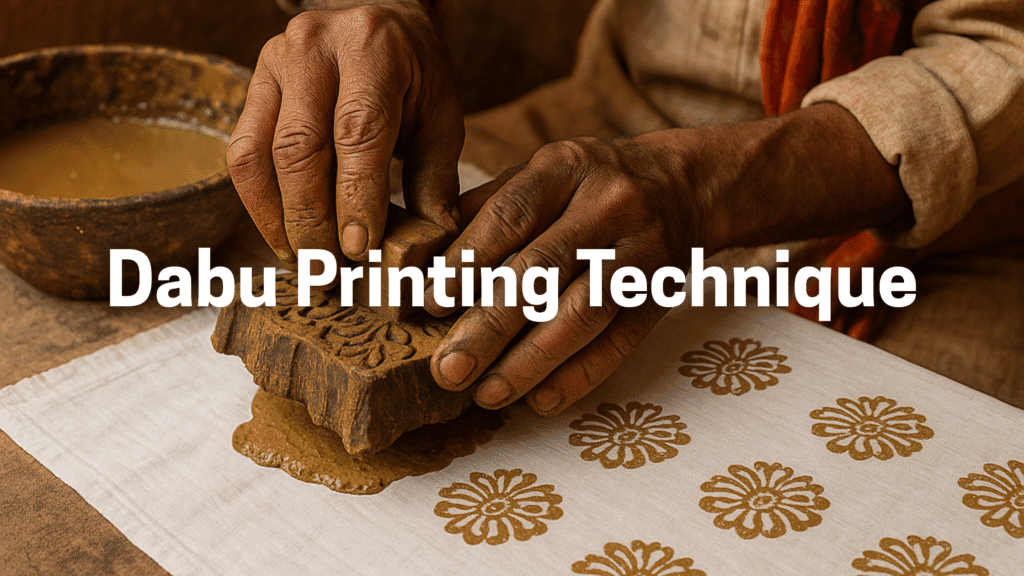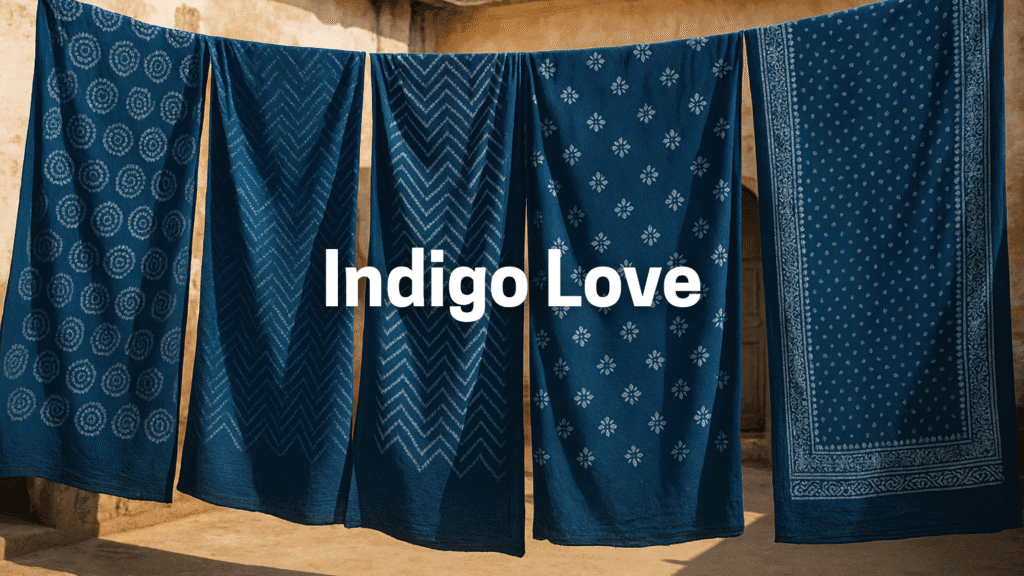Mud, Music, and Magic: Discovering the Secrets of Dabu Printing
An Ancient Whisper in Clay
Can you imagine a world where mud becomes magic? Where earth and water conspire to create patterns so beautiful, they hold the very soul of the desert within their threads?
Welcome to the mystical realm of Dabu printing—an art so rooted in the earth that it literally uses mud as its muse. This isn’t just any printing technique; this is a conversation between the artisan’s hands and the ancient wisdom of clay, a dance that has been choreographed over centuries in the sun-soaked villages of Rajasthan.

The Poetry Written in Mud
The word “Dabu” comes from the Hindi word “dabana,” which means “to press”. But oh, how that simple word carries the weight of so much more. It carries the gentle pressure of wooden blocks against soft fabric, the patient pressing of dreams into reality, the tender insistence of tradition against the rushing tide of modernity.
Here, in the villages of Bagru and Akola, where the Chhipa community has lovingly guarded this secret for nearly 500 years, every piece tells a story that began long before our grandmothers were born. Some say the technique traveled from China around 675 AD, finding its truest home in the clay-rich banks of Rajasthan’s rivers.
The Secret Recipe: Earth’s Own Alchemy
Every family guards their Dabu paste recipe like a cherished heirloom, passed down through whispered instructions and watching eyes. But I’ll share with you the magic that happens when earth meets intention.
The sacred paste is born from:
- Black clay gathered from dried pond beds—preferably where buffaloes have walked, their hooves grinding the earth to perfect fineness
- Lime water (chuna) to prevent cracking and improve adhesion
- Natural gum from the babool tree, binding all with nature’s own glue
- Wheat chaff or spoiled wheat flour, adding texture and strength
- Jaggery sometimes, for that extra sweetness that earth craves
This mixture is soaked overnight, like a meditation in patience, then strained through fine muslin until it becomes smooth as silk. Each artisan’s hand knows the exact consistency—too thick and it won’t release from the block, too thin and it won’t resist the dye.

The Sacred Dance of Creation
Picture this: dawn breaks over Bagru, and the artisan spreads pure cotton fabric on long tables. The cloth has already journeyed through its first transformation—washed in turmeric-rich myrobalan water, giving it a gentle golden glow that welcomes color like an old friend.
Now comes the heart of the magic. The artisan dips carved wooden blocks—some passed down through generations—into the sacred mud paste. With a rhythm older than memory, they press down, lift, press down, lift. Each impression is a fingerprint of intention.
But here’s where Dabu reveals its genius: immediately after printing, fine sawdust is sprinkled over the wet mud like stardust. This isn’t just for aesthetics—the sawdust absorbs excess moisture and creates a protective barrier, ensuring the paste holds firm during dyeing.

Where Indigo Dreams Come Alive
After sun-drying—because in Dabu, the sun is always a partner—the fabric takes its most transformative bath. Into vats of deep indigo it goes, the color of twilight skies and infinite possibilities. Areas covered by mud resist remain untouched by the dye, creating patterns that seem to breathe with life itself.
The indigo dyeing is its own meditation. The fabric is dipped and oxidized multiple times—sometimes six to ten cycles—to achieve that profound blue that makes your heart pause. With each emergence from the dye bath, the fabric transforms from green to deepest blue as oxygen works its alchemy.
Traditional colors whisper their own stories:
- Indigo from the sacred Indigofera tinctoria plant
- Madder red from the manjishtha root
- Pomegranate yellow-green from nashpal
- Turmeric’s golden blessing from haldi
The Beauty of Imperfection
When the mud is finally washed away—in a process lovingly called “dhulai”—the true magic reveals itself. Some dye always seeps through tiny cracks in the mud, creating those characteristic veined patterns that make each piece utterly unique. This isn’t a flaw—this is the signature of the human hand, the proof that something beautiful was born from love and patience, not machines.
Motifs That Dance with Nature
The patterns carved into Dabu blocks read like poetry written in wood:
- Peacocks strutting with pride
- Mangoes heavy with summer sweetness
- Sunflowers following the light
- Cornstalks swaying in desert winds
- Geometric dreams that speak of ancient mathematics
Traditional designs like kahma, lal titri, dholika, and kantedar carry names as beautiful as the patterns themselves.
A Craft Reborn for Tomorrow
In our world of fast fashion and fleeting trends, Dabu printing stands as a gentle revolutionary. This ancient technique has quietly been sustainable all along—using natural dyes, biodegradable materials, and processes that honor rather than harm the earth.
Modern brands and conscious consumers are rediscovering what our ancestors always knew: that true beauty takes time, that the most precious things are made by hands that understand patience. At SA Fab, we honor this wisdom by offering Dabu fabrics in 10-meter rolls, allowing you to feel the story in every thread, whether for a single cherished garment or bulk orders that spread this magic wider.
The Heartbeat of a Community
Behind every Dabu print is a artisan whose family has kept this flame burning for centuries. In villages like Bagru, where narrow lanes are draped with drying fabrics like prayer flags, the Chhipa community continues this sacred work.
These aren’t just craftspeople—they are storytellers, guardians of knowledge, keepers of secrets that cannot be learned from books. When you choose Dabu, you choose to support hands that have perfected their art through generations of love.
Your Part in This Ancient Story
What calls to you about Dabu printing? Is it the way earth and water become art? The patience required to create something truly beautiful? The knowledge that your choice supports artisans whose craft connects you to centuries of wisdom?
When you wrap yourself in Dabu-printed fabric, you’re not just wearing cloth—you’re carrying forward a conversation between human creativity and natural abundance that began with the first person who noticed that mud could preserve pattern.
What story would you like your next garment to tell?
I would love to hear from you.
With earth in my hands and dreams in my heart,
FAQs
A: Dabu printing is an ancient mud-resist hand-block printing technique from Rajasthan where a natural mud paste is applied to fabric using carved wooden blocks. The mud acts as a resist during dyeing, creating beautiful patterns when washed away.
A: The name comes from the Hindi word “dabana” meaning “to press,” referring to the pressing action used to apply the wooden blocks onto fabric with the mud paste.
A: The Dabu paste is made from locally sourced black clay, lime, natural gum, and wheat chaff. Each artisan family guards their secret recipe, passed down through generations, and the paste must achieve perfect consistency to work properly.
A: Dabu printing uses only natural, biodegradable materials—mud, plant-based dyes, organic cotton, and traditional processes. It has zero carbon footprint and supports sustainable fashion practices.
A: The characteristic veining occurs when small amounts of dye seep through natural cracks in the mud resist. This isn’t a flaw but a beautiful signature of the handmade process that makes each piece unique.
A: The complete process can take several days to weeks, including fabric preparation, mud application, drying, multiple dyeing cycles, and washing. True Dabu cannot be rushed—it follows nature’s timeline.
A: While regular block printing applies dye directly to fabric, Dabu uses mud as a resist before dyeing. This creates contrasting patterns where the mud-covered areas remain undyed, resulting in more complex, layered designs.
A: Traditionally done on cotton, Dabu printing now works on various natural fabrics including silk, linen, and organic cotton. The fabric must be absorbent enough to properly hold both the mud resist and the dyes.